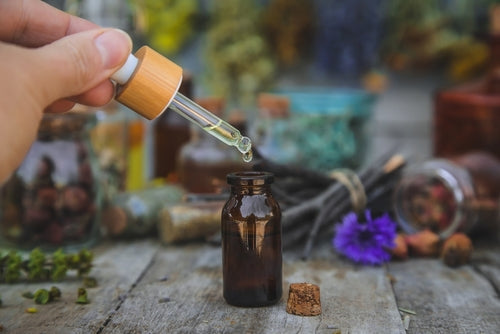
A Guide to Mushroom Tincture Extraction Methods: Soxhlet vs. Ultrasonic
10/14/24Share

Mushroom tinctures, concentrated liquid extracts of beneficial mushroom compounds, are gaining popularity for their potential health benefits. Creating these tinctures involves separating desired compounds from the mushroom's cellular matrix, a process achieved through various extraction methods. This blog post will explore the pros and cons of two popular methods, Soxhlet and Ultrasonic extraction, focusing on their application in making mushroom tinctures.
Soxhlet extraction, a well-established method, utilizes a specialized apparatus to repeatedly cycle fresh solvent through the mushroom material. This continuous process, driven by solvent heating, vaporization, and condensation, aims to maximize the extraction of soluble compounds.
If you want to buy mushroom grow kits or supplies for beginners, you can check out more on our store
Soxhlet Extraction: Traditional Approach with Limitations

Advantages:
● Thoroughness: The continuous cycling of fresh solvent allows for a thorough extraction, particularly for compounds with low solubility.
● Hands-Off Process: Once set up, the Soxhlet apparatus can run autonomously, requiring minimal supervision.
Disadvantages:
● Time-Consuming: The Soxhlet process can be quite slow, often taking hours or even days to complete.
● High Solvent Usage: Large volumes of solvent are needed, increasing costs and environmental impact.
● Heat Degradation: The high temperatures used in Soxhlet extraction can degrade heat-sensitive compounds, particularly crucial for preserving the delicate bioactive compounds found in mushrooms.
● Incomplete Extraction: Some compounds trapped within rigid cell structures may not be fully extracted.
● Particle Size Issues: Smaller particles increase extraction efficiency but can clog the apparatus, while larger particles may result in incomplete extraction.
Ultrasonic Extraction: A Modern and Efficient Alternative

Ultrasonic extraction harnesses the power of high-frequency sound waves to enhance the extraction process. This method disrupts cell walls and increases mass transfer through cavitation, the formation and implosion of microscopic bubbles within the solvent.
Advantages:
● Speed and Efficiency: Ultrasonic extraction significantly reduces extraction times, often completing in minutes rather than hours or days.
● Higher Yields: The cavitation effect allows for more complete extraction, often resulting in higher yields compared to traditional methods.● Gentle Processing: This method operates at lower temperatures, preserving the integrity of heat-sensitive bioactive compounds crucial for mushroom tinctures.● Environmentally Friendly: Compatible with mild, eco-friendly solvents like water and ethanol.
● Precise Control: Modern ultrasonic extractors allow for fine-tuning of parameters like amplitude, frequency, and temperature, ensuring consistent and reproducible results.
Disadvantages:
● Potential for Degradation (If Not Properly Controlled): While generally a gentle method, excessive sonication can degrade certain compounds. Careful optimization of parameters is essential.
● Initial Equipment Cost: Ultrasonic extraction equipment can have a higher initial investment compared to basic setups for traditional methods.

"Based on your interest in maximizing health benefits from mushroom tinctures, it's worth comparing the Soxhlet method to other extraction techniques, especially ultrasonic extraction."
Choosing the Best Method: A Matter of Priorities

Both Soxhlet and Ultrasonic extraction have their strengths and weaknesses.
Soxhlet , while traditional and thorough, can be slow, resource-intensive, and potentially damaging to heat-sensitive compounds.
Ultrasonic extraction , on the other hand, offers a faster, more efficient, and gentle approach but may require a higher initial investment.
For mushroom tinctures , where preserving the delicate bioactive compounds is paramount, Ultrasonic extraction emerges as a strong contender. Its speed, efficiency, and low-temperature operation make it ideal for maximizing the therapeutic potential of these valuable fungi.
Related Readings
Frequently Asked Questions
Q1: What is a mushroom tincture?
A: A mushroom tincture is a concentrated liquid extract made by soaking mushrooms in alcohol or another solvent to pull out their beneficial compounds. This process results in a potent, easily absorbable form of mushroom extract.
Q2: What's the main difference between Soxhlet and Ultrasonic extraction?
A: The main differences lie in their efficiency, temperature use, and extract quality. Ultrasonic extraction is generally quicker, uses lower temperatures, and often produces higher-quality extracts compared to Soxhlet extraction.
Q3: Which method is better for preserving heat-sensitive compounds?
A: Ultrasonic extraction is generally better for preserving heat-sensitive compounds because it operates at lower temperatures compared to Soxhlet extraction.
Q4: Is Soxhlet extraction still relevant given the advantages of ultrasonic extraction?
A: Yes, Soxhlet extraction is still relevant. It's particularly useful for substances with low solubility in a solid matrix and can operate autonomously for long periods. In some cases, it can also be enhanced by combining it with ultrasonic extraction.
Q5: How does particle size affect Soxhlet extraction?
A: In Soxhlet extraction, smaller particles offer a larger surface area for extraction, which can be beneficial. However, smaller particles are also more prone to agglomeration (clumping together), which can hinder the extraction process.
Q6: Are there any drawbacks to ultrasonic extraction?
A: While our sources didn't list specific cons for ultrasonic extraction, one potential drawback is the initial cost of equipment. A basic ultrasonic emulsifier can cost around $1200 CAD, which might be a significant investment for some.
Q7: Can these extraction methods be used for other botanicals besides mushrooms?
A: Yes, both Soxhlet and ultrasonic extraction methods can be used for a wide variety of botanicals, not just mushrooms. They're commonly used in herbal medicine, essential oil production, and other fields requiring botanical extraction.
Q8: Is it safe to perform these extractions at home?
A: While it's possible to perform some extractions at home, it's important to note that working with botanical extracts can be complex and potentially hazardous. It's strongly recommended to conduct thorough research, use proper safety equipment, and ideally consult with experts before attempting any extraction methods on your own.
Products Featured In This Blog

Lavender Lion's Mane Latte
Prep time
1
Cook time
5
Category
coffees
This floral-infused latte combines the cognitive benefits of lion's mane with calming lavender.
- 1 shot espresso or 1/2 cup strong coffee
- 1 cup oat milk
- 1 tsp lion's mane powder
- 1/4 tsp dried culinary lavender
- 1 tsp honey
- Pinch of sea salt
Brew the espresso or coffee. Steep the lavender in the hot oat milk for 5 minutes, then strain. Mix the lion's mane powder into the coffee. Add honey and salt. Pour the lavender-infused milk over the coffee mixture.
Disclaimer: The information presented here is based on research and should not be considered medical advice. Always consult with a qualified healthcare professional before using mushroom tinctures or making any decisions regarding your health.
This page has been viewed 0 times.




